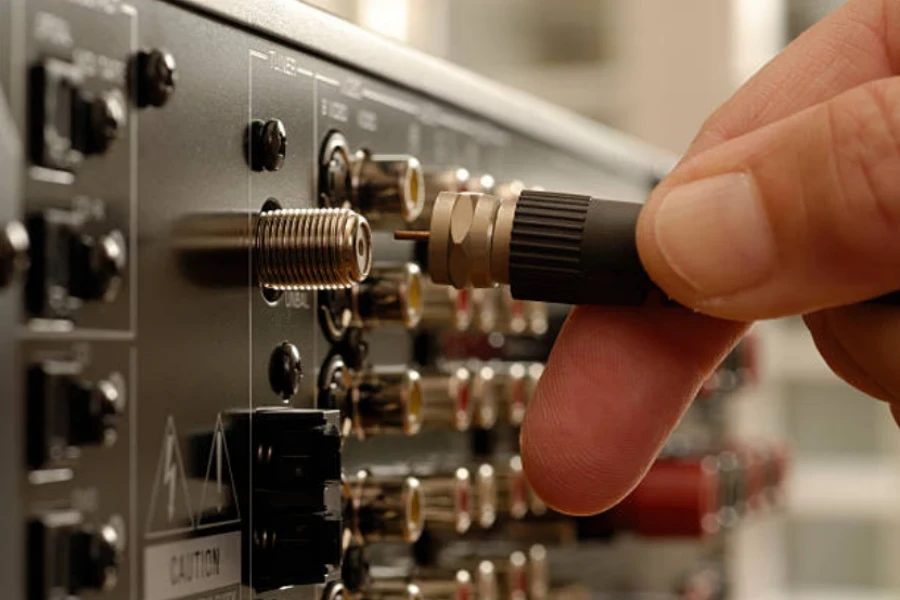In the realm of modern technological setups, audio and video cables stand as silent pillars. These seemingly simple components play a pivotal role in ensuring seamless communication between devices, translating to crisp sound and vivid visuals. For businesses, understanding the nuances of these cables is more than just technical knowledge; it’s about ensuring optimal performance and delivering unparalleled experiences. Whether it’s a high-stakes presentation or a product showcase, the right cables can make all the difference. As the tech landscape continues to evolve, staying informed about these essential connectors becomes not just a choice, but a necessity for those aiming for excellence.
Table of Contents
Defining audio & video cables
Market trends and developments in 2024
Types and usage of audio & video cables
Expert advice on cable selection
Conclusion
Defining audio & video cables
In today’s interconnected world, audio and video cables serve as the backbone for a myriad of technological applications. These cables, often overlooked, are the conduits that ensure the clarity of sound and the vibrancy of visuals in various setups.

The essence of audio cables
Audio cables are integral in transmitting sound signals from one device to another. Their primary function lies in ensuring that sound, whether it’s music, dialogue, or any auditory element, is relayed without loss of quality. Commonly, these cables find their application in connecting devices like speakers, stereo systems, and microphones. The quality and type of these cables can significantly influence the sound output, making them a critical component in audio setups.
The essence of video cables
Video cables, on the other hand, are responsible for transmitting visual data. Their role is paramount in ensuring that visuals are displayed with clarity, color accuracy, and without any lag. These cables are commonly used in setups involving computers, monitors, gaming consoles, and televisions. As technology advances, the demand for high-quality video cables has surged, especially with the rise of high-definition content and devices. Ensuring the right video cable is used can make the difference between a pixelated display and a crystal-clear viewing experience.
Market trends and developments in 2024
The realm of audio and video cables is not static; it’s a dynamic field that continually evolves, reflecting the broader technological landscape’s shifts and innovations. Experts currently value the global audio cable market at USD 831.4 million, and they expect it to reach USD 1199.5 million by 2028, growing at a 6.3% compound annual growth rate (CAGR) from 2023 to 2028. On the video front, the HDMI cable market, a significant segment in the video cable domain, was valued at USD 2113.75 million in 2022. It’s projected to ascend to USD 3225.06 million by 2028, with a 7.3% CAGR from 2023 to 2028.

Evolution of cable technology
Advancements in materials and designs have propelled the capabilities of audio and video cables to new heights. These enhancements not only improve signal quality but also cater to the ever-changing preferences of businesses and professionals. For instance, the emergence of flexible screens, such as rollable displays, hints at the potential future of space-saving and portability in AV setups. Similarly, touchless displays, which rely on AI and sensors, have gained traction, especially given the heightened concerns surrounding touch interfaces in the current health climate.
Impact of tech innovations on cable choices
Emerging technologies invariably influence the requirements for audio and video cables. The rise of hologram projections, for instance, necessitates cables capable of transmitting complex visual data without compromise. While current hologram projection equipment has its limitations, advancements like Light Field Labs’ SolidLight promise a future where 3D objects appear tangible.
Furthermore, the increasing adoption of Augmented Reality (AR) and Virtual Reality (VR) in various sectors, from education to corporate training, underscores the need for cables that can handle these immersive experiences. Another notable trend is the shift towards invisible sound technology, where speakers seamlessly integrate into walls or ceilings, preserving aesthetic integrity without compromising on sound quality. The adoption of spatial audio, offering a 360-degree sound stage, is revolutionizing experiences from conference calls to entertainment. As businesses look to the future, the move towards a cable-less environment with AV over IP technology is evident, promising scalability, flexibility, and cost-effectiveness.
Types and usage of audio & video cables
In the realm of modern technology, the significance of audio and video cables cannot be overstated. These cables serve as the lifelines for transmitting sound and visual data, ensuring that devices communicate effectively and deliver the desired output.

Highlighting prominent audio cables
Audio cables play a pivotal role in transmitting sound signals between devices. Whether it’s the soft strumming of a guitar or the intense dialogue in a movie, these cables ensure that the sound is relayed without any loss of quality.
Several types of audio cables are prevalent in the market, each with its unique features and use cases. Among them, RCA cables are versatile and commonly used for stereo systems. XLR cables, known for their balanced sound transmission, are a favorite in professional audio setups. The 3.5mm cable, often referred to as the auxiliary cable, is ubiquitous, connecting devices like smartphones to speakers or car audio systems.
Spotlight on video cables
Video cables are responsible for transmitting visual data. The clarity of a movie, the resolution of a video game, or the sharpness of a presentation, all depend on the quality and type of video cable used.
Several video cables dominate the market. HDMI, known for its high-definition transmission, is a standard for modern TVs and monitors. VGA, an older standard, is still prevalent in some projectors and older computer monitors. DVI offers a mix of analog and digital video signals, while DisplayPort is emerging as a favorite for high-resolution displays and gaming setups.
The convergence of audio and video in single cables
The tech world has seen a rise in cables that can transmit both audio and video signals. These combined cables offer the advantage of reduced clutter and simplified connections. For instance, HDMI not only delivers high-definition video but also supports multi-channel audio, making it a preferred choice for home theaters and gaming consoles.
In setups where space is a constraint or where minimalism is desired, combined cables come to the rescue. They eliminate the need for multiple cables, leading to a cleaner setup. Moreover, in professional environments where quick setups and teardowns are common, these cables can save time and reduce the chances of connection errors.
In conclusion, understanding the types and uses of audio and video cables is crucial for anyone involved in the tech industry. By choosing the right cable for the right job, one can ensure optimal performance and longevity of their devices.
Expert advice on cable selection
In the intricate world of audio and video setups, the choice of cables can significantly influence the overall performance. While it might seem like a minor detail, the type and quality of cables used can make or break the experience.

Importance of cable quality
High-quality cables often translate to enhanced performance. They ensure minimal signal loss, reduced interference, and optimal transmission, resulting in clearer audio and crisper visuals. It’s not just about the immediate experience; quality cables also offer consistent performance over time.
Several factors determine the durability of a cable. The materials used, the shielding technique, and the manufacturing process all play a role. For instance, gold-plated connectors resist corrosion better, and braided shields offer superior protection against interference. Investing in quality ensures that the cables not only perform well but also last longer, offering better value in the long run.
Analog vs. digital: making the right choice
Analog and digital cables have distinct ways of transmitting signals. While analog cables transmit continuous signals, digital ones send discrete signals. This fundamental difference can influence the clarity and quality of the transmission.
Analog cables, like RCA, are often favored for their warmth in audio setups, especially in certain music genres. However, for high-definition visuals and multi-channel audio, digital cables, such as HDMI, are the go-to choice. The decision largely depends on the specific requirements of the setup and the desired output.
Considerations for specific setups
Different setups demand different cables. For instance, a professional recording studio might prioritize XLR cables for their balanced audio transmission, while a gaming setup might lean towards HDMI for its high-definition video and audio capabilities.
It’s essential to match the cable to the device’s specifications. For high-resolution displays, cables that support the required resolution and refresh rate are crucial. Similarly, for audio setups, ensuring the cable can handle the desired frequency range is vital. Regular maintenance, like checking for wear and tear and ensuring connectors are clean, also plays a role in maintaining optimal performance.

In essence, the right cable can elevate the experience, ensuring that devices deliver their best. Making informed choices based on the setup’s requirements and the cables’ capabilities is the key to achieving the desired output.
Conclusion
In the intricate dance of technology, audio and video cables play a pivotal role, often overlooked but crucial in ensuring optimal performance. As the tech landscape continually evolves, the importance of making informed cable choices becomes even more pronounced. For businesses and professionals, understanding the nuances of these cables isn’t just about technical know-how; it’s about ensuring that every presentation, every showcase, and every interaction is at its best. As the march of innovation continues, staying updated and making informed decisions will remain the cornerstone of excellence in audio and video setups.




